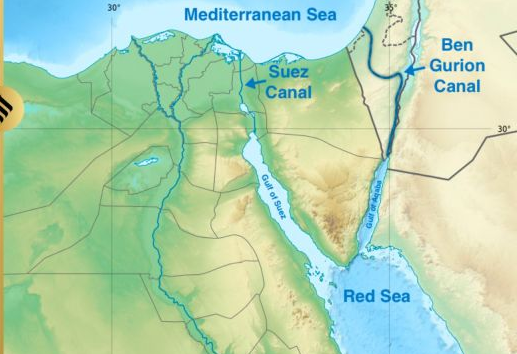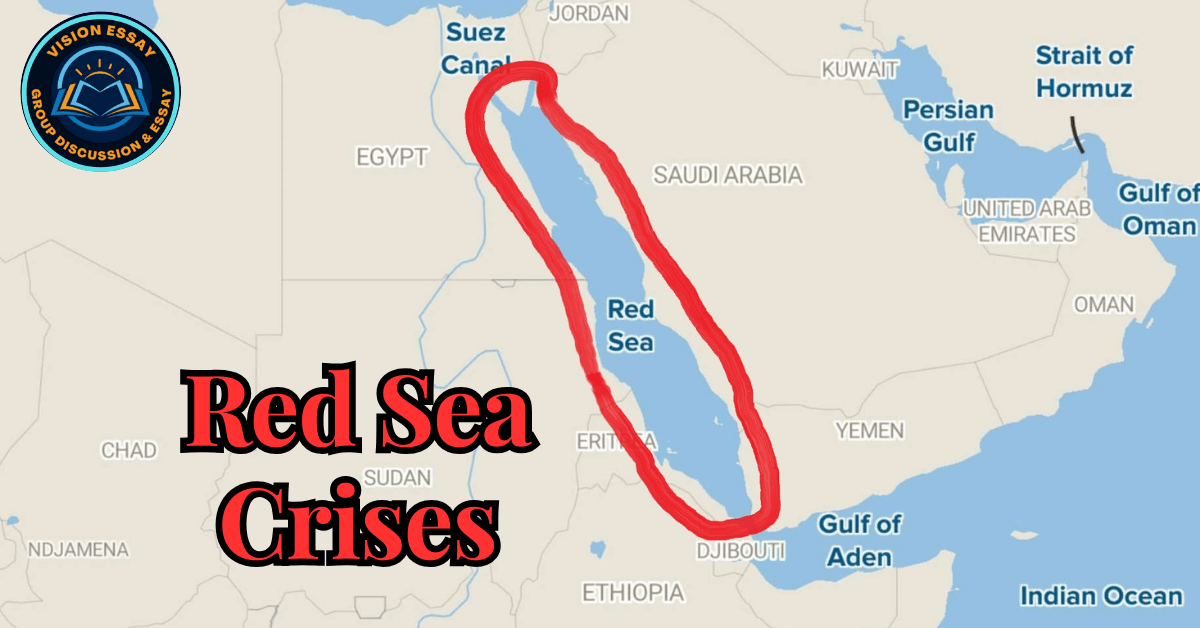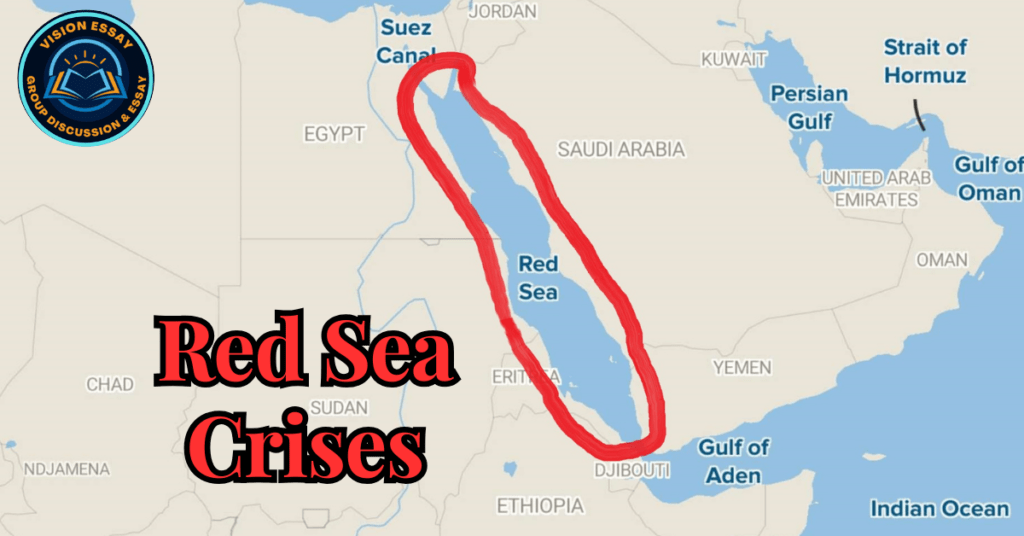Rising Of The Red Sea Crisis
Introduction
According to the Ministry of Commerce and Industry (MoCI), the growing Red Sea Crisis and persistent drought problems at the Panama Canal are causing interruptions to India’s exports to Europe, particularly low-value goods like textiles and agriculture. Concerns over possible effects on international commerce were addressed in response to an interministerial conference presided over by the Union Commerce Secretary and included important ministries such as External Affairs, Defense, Shipping, and the Department of Financial Services (DFS) under the Ministry of Finance.
What is the Red Sea?
- The Arabian Peninsula borders the Red Sea on the east and northern Africa on the west. The Red Sea is a semi-enclosed tropical basin.
- The basin is long and narrow, spanning from the Indian Ocean to the southeast and the Mediterranean Sea to the northwest.
- It splits into the Gulf of Suez and the Gulf of Aqaba at its northernmost point. The Gulf of Suez is connected to the Mediterranean Sea via the Suez Canal.
- Through the Strait of Bab-el-Mandeb, it is connected to both the Gulf of Aden and the outer Indian Ocean at its southernmost point.
- There is no significant influx of freshwater, and it is encircled by desert or semi-arid regions.
What are the Current Problems with the Panama Canal and the Red Sea?
Red Sea
- Issue
- A drone assault occurred on the chemical tanker MV Chem Pluto around 200 nautical miles off the coast of Gujarat.
- The chemical tanker MV Chem Pluto is operated by the Netherlands, owned by Japan, and flying the Liberian flag. It was scheduled to arrive at New Mangalore, India, having departed with oil from Al Jubail, Saudi Arabia.
- Allegedly Involved Entity
- Houthi militants from Yemen are thought to have carried it out in retaliation for Israel’s activities in Gaza.
- In addition, the Houthi rebels and the Yemeni government are involved in a ten-year civil battle.
Panama Canal
- Issue
- Shipping through the 51-mile section of the Panama Canal has dropped by more than 50% as a result of the drought.
- The drought in Panama is partly caused by a naturally occurring El Nino climatic trend linked to warmer-than-normal water in the central and eastern tropical Pacific Ocean.
- Infrastructural Lacunae
- The difficulties in operating the Panama Canal and the commercial shift to other routes, such as the Red Sea, have brought up several issues that need to be addressed right now.
- Problems with decreasing depth and dredging have surfaced, making it difficult for big ships to navigate. It is imperative to take immediate action to solve these issues.
What is the Impact on India Due to the Red Sea Crisis?
- Impact on Agricultural Commodities
- Exporters of vital goods like tea and basmati rice are worried about the delays to this important trading route.
- If the Red Sea route is disrupted, shipping across the Cape of Good Hope might result in a 10–20% rise in the price of Indian agricultural products.
- Impact on Oil and Petroleum Trade
- Major shipping firms have avoided the Red Sea, which has resulted in a reduction in global oil and petroleum flows. India continues to purchase oil from Russia, albeit, untouched.
- India’s reliance on Russian oil—which is seen as Iran’s ally—has not changed despite the Red Sea crisis.
- Costlier Export to the US
- Ships sailing from Asia to the US are being forced to use the Suez Canal due to a water shortage in the Panama Canal and the associated drought. This means that the Suez Canal route takes six extra days to complete than the Panama Canal route.
- Panama Canal as not a Feasible Option
- While the 100-year-old Panama Canal connects the Atlantic and Pacific Oceans and is not a particularly practical alternative for India, the Bab-el-Mandeb Strait leads to the Suez Canal in the Red Sea area, connecting Asia to Europe.
Also read: India-Maldives Relationship: A Diplomatic Conflict
What Factors are Contributing to the Red Sea Crisis?
- Modern Weaponry Concerns
- The situation around the Red Sea is getting more complicated, which affects trade and stability.
- The employment of cutting-edge weapons calls into question the efficacy of international defense cooperation, giving rise to worries about trade disruption and assertions of high interoperability.
- Adaptation of Piracy Techniques
- Like with previous piracy issues, rebels have been able to adapt to contemporary technology due to the tardiness of international reactions.
- The ‘High-Risk Area’ has been expanded, strategies including hijacking ships and using them as mother ships have been employed, and maritime traffic has been impacted by rerouting and higher insurance costs.
- State Support and Missile Proliferation
- Concerns over the proliferation of missile technology are raised by the Houthi rebels’ use of drones and Anti-Ship Ballistic Missiles (ASBMS), as well as possible state help from China and Iran.
- The problem is made more difficult by the direct or indirect connection to China for the supply of ASBMS.
- Lacklustre Response to Operation Prosperity Guardian
- Allies and allies have responded tepidly to the U.S.-launched Operation Prosperity Guardian, which is supposed to operate under the Combined Maritime Force.
- There are concerns regarding the United States’ capacity to lead global cooperation institutions given the independence with which NATO members like France, Italy, and Spain conduct their affairs.
- Saudi Arabia and UAE’s Non-Participation
- Complexities are shown by Saudi Arabia’s withdrawal from the operation, which was probably done to prevent bad effects on Yemeni discussions and relations with Iran.
- Maybe the UAE is reluctant because they don’t want to be seen as supporting Israel.
- India functions autonomously even though it is a full member; this may be because of its ties to Iran.
- Global Division on Maritime Security
- The Prosperity Operation The incapacity of Guardian to operate as a coalition exposes differences among like-minded countries that uphold the freedom of navigation as required by the United Nations Convention on the Law of the Sea (UNCLOS).
- The fact that even American allies like Japan and Australia have not joined highlights the divergence in views on maritime security and a rule-based international order.
What Steps Can India Take to Reduce the Red Sea Crisis?
- Joint Maritime Security Initiative: With the help of Yemen, Saudi Arabia, Egypt, and other important Red Sea allies, suggest a cooperative security structure that includes intelligence sharing, coordinated patrols, and joint drills.
- Deploy Advanced Surveillance Systems: To improve early threat detection and response capabilities, install integrated radar and drone monitoring systems along India’s western coastline.
- Negotiate Preferential Access: Speak with the Panama Canal authorities about possible toll reductions for particular routes or preferred access for Indian vessels.
- Alternate Trade Routes Under Consideration: The Ben Gurion Canal Project, a proposed 160-mile sea-level canal that would connect the Mediterranean Sea with the Gulf of Aqaba and avoid the Suez Canal, has recently attracted new attention.

- Avoiding Yemen as a Battleground: By preventing the Houthis from becoming recognized as a legitimate state actor, a feasible end state is required, underscoring the need to prevent Yemen from becoming another Lebanon-like front in the war.
- Facilitating Export Credit: Concerned about consignment holds brought on by exorbitant freight and surcharges, the MoCI has directed DFS to guarantee exporters get credit constantly.
- Maintaining Buffer Stocks: India won’t experience a fertilizer shortage as a result of Red Sea tensions, the Ministry of Chemicals and Fertilizers promised.
Conclusion
A complex problem is presented by the Houthi rebels’ growing hostility in Yemen and their attacks on commercial ships in the Red Sea. The rebels’ deployment of sophisticated weapons, like as drones and ballistic missiles meant to destroy ships, highlights their capabilities and raises questions about possible state help, especially from China and Iran. The need for a workable and feasible end state that keeps Yemen from becoming a protracted battlefield is highlighted by the need for a cautious and measured approach as the situation develops to stop further deterioration.
Frequently Asked Questions(FAQs)
What is the Red Sea Crisis?
Based on changes in vessel capacity, the newest data from maritime advice firm Sea-Intelligence shows that the Red Sea crisis and ongoing Houthi rebel attacks on cargo ships and tankers have had a greater impact on shipping than the early epidemic.
Why this is called the Red Sea?
Of all the seas that join the ocean, the Red Sea has the highest salinity since it is the only one where no river meets the ocean. According to a common theory, the Red Sea got its name because of a cyanobacterium called Trichodesmium erythraeum, which gives the typically blue-green water in the area a reddish-brown color.
What countries are in the Red Sea?
Among the world’s saltiest bodies of water. Egypt, Saudi Arabia, Yemen, Sudan, Eritrea, and Djibouti are the countries that share borders.
What is the Red Sea famous for?
Popular diving and snorkeling destinations, the Red Sea is renowned for its colorful coral reefs, abundant marine life, and crystal-clear blue waters. It is actually among the greatest in the entire globe.
Sources:
- Red Sea crisis: Why escalating violence in the Middle East isn’t pushing up gas prices | CNN Business
- Red Sea Rising | Crisis Group
- What Does the Red Sea Crisis Mean for Oil Prices? – The New York Times (nytimes.com)
- Xinhua Headlines: Rising Red Sea tensions rattle global shipping industry, spark concerns of spillover from Gaza conflict – China.org.cn

